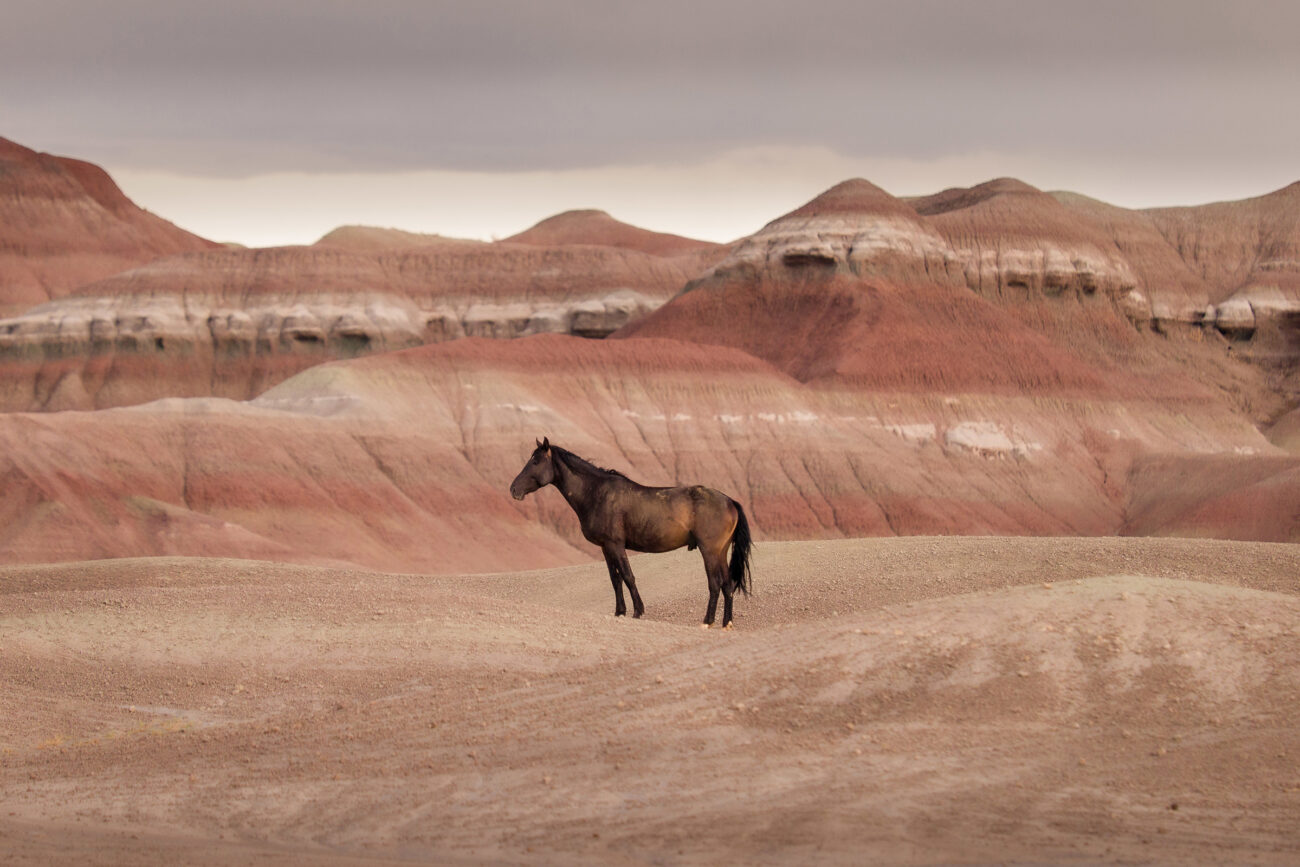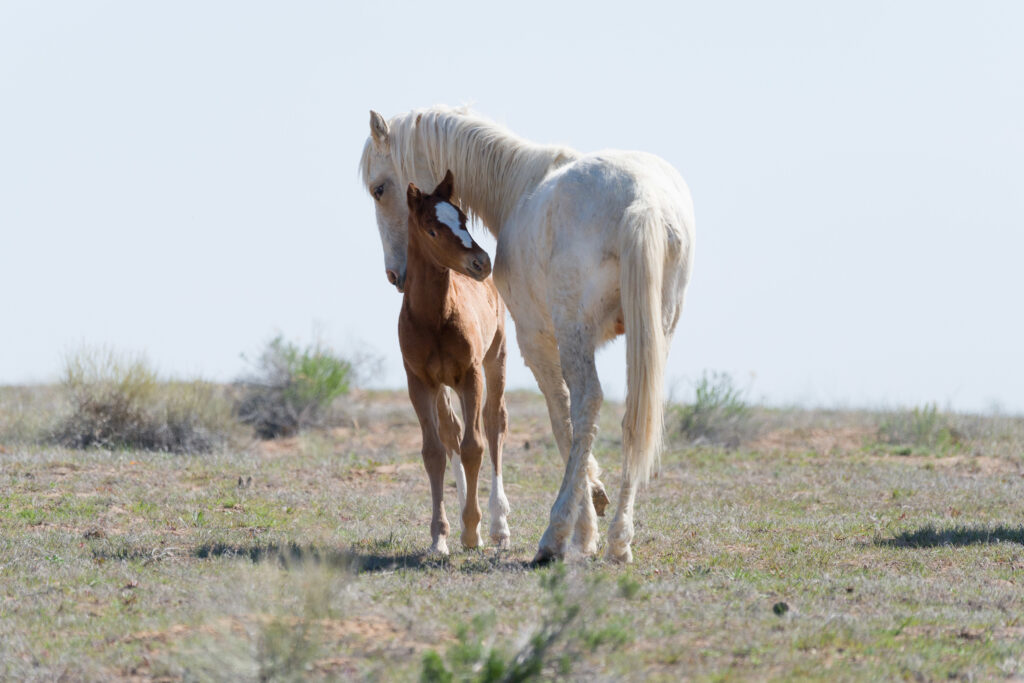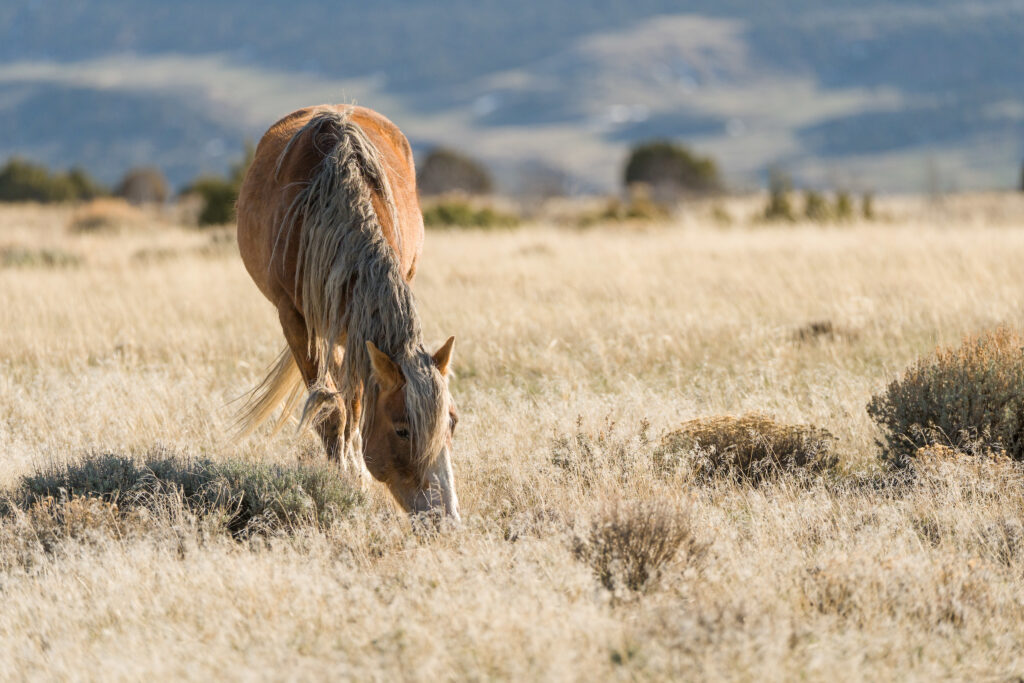Unbridled Impact: The Wicked Predicament of Wild Horses on Public Lands

With ballooning populations, wild horses and burros are teetering on the edge of crisis
By Lael Gilbert
Perhaps you were in a movie theater in the late 1970s, as a sunburnt boy used his pocket knife to cut through a tangle of rope binding a jet-black stallion on an abandoned beach.
You might have witnessed the kid bonding with the animal over sun-drenched days, and finally daring to grip a fistful of the horse’s midnight mane, sliding a skinny leg over its muscled back and hoisting himself to mount. Maybe you, like me, fell in love at that moment. Not with the kid … with that horse.
If the movie The Black Stallion didn’t thrill your young soul like it did mine, there are plenty of other horse stories that perhaps did, each leveraging that undeniable emotional bridge connecting horse and human. Graceful and intelligent, affectionate and independent, horses are astonishingly easy to love.
The bond goes deeper than fiction, of course — horses are an icon of the American West. But even as cultural connections to tasks like herding and plowing fade for most of us, our bond to the horse seems to endure. People really care about horses, even when they don’t have much experience with them. This makes the management of wild horses, very real animals currently eating and breeding their way across public lands of the Western U.S., a very difficult task.
Last year 83,000 free-roaming horses and burros, all protected by a strict federal mandate, lived on public lands.
“Many people aren’t even aware that wild horses exist, let alone that they’ve become a major management issue on public lands in the West,” says Nicki Frey, a USU wildlife biologist studying human-wildlife conflicts. “It’s easy to imagine wild horses roaming the grassland in Wyoming or Montana, but the vast majority of these herds actually live in fragile desert ecosystems.”
Nevada is home to more than half of the total wild horse populations in North America, and Utah is home to 22 herds.
“There are too many horses and burros in some areas,” says Eric Thacker, Extension range specialist from the Quinney College of Natural Resources at USU. “The arid West simply can’t support excess numbers of the animals. Dry landscapes have limited forage and offer meager water. What horses take from the land in those places directly competes with the needs of native wildlife and livestock.”

The well-intentioned law that protects wild horses, The Wild Free-Roaming Horses and Burros Act of 1971, was an outcome of a major public letter-writing campaign that occurred just a decade before The Black Stallion hit theaters. However, the modern application has become mired with modifications and curtails certain actions to control horse populations, including euthanasia, unrestricted sale, and slaughter. This has allowed herds to increase exponentially, putting land managers in a seemingly unwinnable bind.
The horses and burros that live in the West today aren’t native to North America. Their nearest horse-like ancestor went extinct about 10,000 years ago. The modern line of equids are descendants of animals that were domesticated about 6,000 years ago in Asia and Europe and were introduced to North America by missionaries and explorers beginning in the late 1400s.
Horse digestive systems are not as efficient as ruminants — animals like bison, deer and sheep — so horses need to consume about 20% more forage than a ruminant of similar body size to survive.
Natural predation also isn’t a solution to curb a hungry horse population.
“Horse habitats have limited overlap with any predators capable of taking down big animals,” said David Stoner, a wildlife ecologist at USU who studies the topic. “A few smaller herds live in wooded, mountainous areas and share space with cougars, but it’s not something you could rely on to limit large populations over vast expanses.
“Horses that live in the sparsely vegetated desert basins are largely immune from cougar predation.”
Slaughter and euthanasia, once used to control animal populations, are not palatable options for most of the modern public, Thacker says. There are additional concerns that horses sold through unrestricted sales will end up in slaughterhouses.
And now, protected by federal legislation, with ballooning populations, wild horses and burros are teetering on the edge of crisis with some animals at a real risk of death by starvation or dehydration.
Unchecked herds are also tough on natural ecosystems, especially during extended drought. Hungry horses demolish plants, compact soils and damage fragile river and stream environments. Meanwhile herd numbers continue to double every four years. Managers tasked with the care of both public lands and the health of the herds are working diligently to respond — but there are just no easy answers.
Part of the challenge, and part of the promise, is how much the public cares about horses.
“Reconciling romantic ideals with the reality of feral horses on sensitive desert rangelands is a socially intractable problem,” Stoner muses. “It’s hard enough to figure out how we do this non-lethally, humanely, and sustainably. But the real challenge is conveying the magnitude and consequences of a problem that largely affects rural America to a public that is satisfied with the Hollywood version of the story.”
Hard enough, it turns out, that there is a voluminous amount of misinformation circulating with the high-stakes emotions at play. It takes an incredible investment of time and patience to understand all the factors at stake and bridge the various philosophical and practical divides that exist among stakeholders.
Not least of these is budget. Commitment to humane strategies comes at a literal cost. Managers left with limited options have to choose strategies that are expensive, controversial, and of limited practicality.
Managers at the Bureau of Land Management organize roundups every three to four years on the agency’s designated horse management areas. These are major operations and are completed most safely (for human and horse) and efficiently when aided by helicopter, according to Jay D’Ewart, a horse and burro specialist from the BLM.
Horses can be gathered from no more than a 10-mile radius to avoid undue stress. They are pushed from the air into temporary corrals, or lured there with food, then moved to holding facilities and given veterinary care.
This strategy isn’t without its critics, and once horses are in captivity, things still aren’t simple. Managers must choose from three options: using a fertility control vaccine (which lasts just one year out of a potential 20-year reproductive lifespan) and releasing animals back into the wild (depending on the area’s legally-mandated carrying capacity), working to find adoptive homes (for tens of thousands of ungentled animals), or moving the horses into long-term holding areas to feed them for the duration of their long lives (up to 25 years).

In 2022 the BLM and the U.S. Forest Service gathered 22,000 wild horses and burros off public lands — the most ever in one year. This is, in no way, a strategy that can be sustained. Approximately 61% of the BLM’s $138.5 million horse and burro management budget went directly to caring for horses and burros already in permanent holding facilities that cannot be adopted. Meanwhile, herds continue to grow — often at rates exceeding 20% each year — and the process will soon need to begin again, gobbling up an ever-greater percentage of the resources.
Adoption of wild horses is highly encouraged and financially incentivized by the BLM, but there are only a finite number of handlers with the knowledge and resources to give a thousand-pound ungentled animal a safe and comfortable place to live.
Because the management of wild horses is so emotionally charged, finding solutions to satisfy every stakeholder is far harder than it might be for other natural resource conflicts, Stoner says, but experts at USU are still determined to make headway.
They’ve established a group that embraces the complexity and tension of the issue: The Free Roaming Equids and Ecosystem Sustainability (FREES) Network. The group includes more than 100 stakeholder groups from across the region. It brings people with diametrically opposing viewpoints face to face to work toward realistic solutions, to build relationships within the network, and to improve communication.
It’s often a tense environment when all the players share a room, as they did at a recent event in St. George, but coordinators witness some progress every time they meet. The biggest challenge is building trust among everyone who cares so fervently about the issue.
A new open-access model called PopEquus, developed by the U.S. Geological Survey, shows promise to further the conversation. It allows users to virtually practice wild horse management with a chosen set of priorities in place. They are able to set goals for herd size, turn on strategies like fertility control, moderate costs, and watch the theoretical horse populations change along with their budget. Anyone can use the information to compare possible management strategies, allowing value-laden decisions to move beyond the purely theoretical.
“The predicament of wild horses and burros is a complex one, and sustainable management will only be accomplished when the public is aware of all the financial and ecological tradeoffs that go into these issues and accepts some responsibility for the consequences of their stated management preferences,” Stoner says.






Melissa Murray September 26, 2023
This article is filled with false information! Shame on this publication! Wild animals are being decimated in this country at the expense of private interests. Government mismanagement and flatout corruption is evident for anyone that scratches the surface. The brutal animal suffering inflicted as a result will forever be a great shame for this nation!
Lisa LeBlanc September 26, 2023
“80,000” wild horses and burros apparently running rampant.across The West – during one of the most pervasive droughts The West has ever experienced.
How is it possible to breed so successfully when water and forage have been so hard to come by?
Because the Bureau says so.
And the cost to the taxpayer in terms of free roaming wild equines?
About 1% of that massive annual budget.
Where is the visual evidence that 80,000 wild equines currently exist on the range?
Its non-existent. This number is based on “estimates” – strictly on the say-so of the Bureau.
And where in this massive population explosion are the mortality statistics?
Nowhere. By the Bureau’s own projections, EVERY mare will breed, EVERY pregnancy will bear a foal, and will repeat this perfection annually.
But here’s the thing: 50% of foals born will not reach their first birthday. If we err cautiously at a mere 10% adult mortality, 8,000 wild horses and burros will die this year alone.
This article is riddled with the same ancient rhetoric that the Wild Horse and Burro Program has used for 50 years to vilify and marginalize these animals because actually managing them on the range isn’t held in as high a regard as removing them.
Also…roundups are now killing these animals with impunity.
Check the gather reports.
Ls September 26, 2023
Why do they need a vaccine? What’s wrong with fixing or vasectomy?
Barbara M Flores September 23, 2023
There is so much misinformation in this article I hardly know where to start.
I have been an advocate for wild horses and burros since 1987, shortly after adopting my first wild horse, and have spent many hours on wild horse herd areas in Colorado, Wyoming and other states. The primary cause of range degradation is over grazing by domestic livestock such as cows and sheep which outnumber wild horses by 10 to 100 times depending on the area.
Just one example of the errors in this article.
Scott Beckstead September 21, 2023
As an alum of USU and a proponent of both wild horses and burros on our public lands and honest and transparent government, I am deeply dismayed to see my alma mater perpetuating this false narrative of a wild horse “crisis” to create a pretext for mass roundups of wild horses and burros to benefit commercial livestock grazing on our western rangelands. Will Utah State Magazine provide a fair opportunity to present the other side of this issue?
Sheila September 23, 2023
I agree, Scott. Why isn’t the current BLM research on longer lasting fertility control vaccine trials discussed as an option? I am also doubtful that helicopter round ups improve safety of the horses during round ups. I think we all agree we don’t want horses starving or dying of dehydration but the author of this article seems to be a proponent of “we’re doing the best we can and using the same methods because it’s too difficult (costs more) to try new things.” I get it. BLM has a budget. “In 2021 and 2022, USDA provided a total of $31 billion to help almost a million farmers offset diminished sales, lower prices, and other losses related to the pandemic. This included farmers who reported harvesting crops, raising livestock, or producing dairy.” http://www.gao.gov It seems if we can spend 31 billion to help farms and ranches maybe we can come up with a few million to manage our wild horse population.